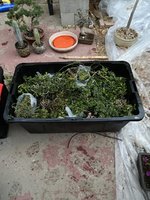hemmy
Omono
Well, it sounds like Ryder truck is going to screw me over on the reefer truck for our move. I had one reserved, but they weren’t supposed to promise me one or they gave it away to a bigger corporate client. So I might get stuck with a straight 26’ box truck driving my plants across I-40 and the 120deg desert. Ryder is trying to source one and I’m on a waiting list for Penske. But it doesn’t look good for our Monday departure.
Has anyone used dry ice to cool large spaces or double box something and use the dry ice to cool but not freeze? There is a commercial place where I get 10lb blocks in large quantities. I’m thinking I could break it into smaller chunks and put it in the boxes but not contacting the trees. Or maybe just use 50-100lbs in the back of the truck to try and keep it under 90-100deg during the day. Then have spare coolers to make the trip. I was going to bag the trees for humidity and transpiration, but if I can’t keep it cool, then I think the bags are out.
Plants are a mix of deciduous, tropical, broadleaf evergreen, conifer and succulents. Trip is 1602 miles from from California to KS through AZ, NM, TX, and OK.
Any thoughts are appreciated!
Has anyone used dry ice to cool large spaces or double box something and use the dry ice to cool but not freeze? There is a commercial place where I get 10lb blocks in large quantities. I’m thinking I could break it into smaller chunks and put it in the boxes but not contacting the trees. Or maybe just use 50-100lbs in the back of the truck to try and keep it under 90-100deg during the day. Then have spare coolers to make the trip. I was going to bag the trees for humidity and transpiration, but if I can’t keep it cool, then I think the bags are out.
Plants are a mix of deciduous, tropical, broadleaf evergreen, conifer and succulents. Trip is 1602 miles from from California to KS through AZ, NM, TX, and OK.
Any thoughts are appreciated!





